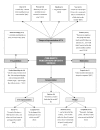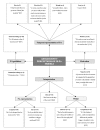Perceptions of Visualizing Physical Activity as a 3D-Printed Object: Formative Study
- PMID: 30698532
- PMCID: PMC6372983
- DOI: 10.2196/12064
Perceptions of Visualizing Physical Activity as a 3D-Printed Object: Formative Study
Abstract
Background: The UK government recommends that children engage in moderate-to-vigorous physical activity for at least 60 min every day. Despite associated physiological and psychosocial benefits of physical activity, many youth fail to meet these guidelines partly due to sedentary screen-based pursuits displacing active behaviors. However, technological advances such as 3D printing have enabled innovative methods of visualizing and conceptualizing physical activity as a tangible output.
Objective: The aim of this study was to elicit children's, adolescents', parents', and teachers' perceptions and understanding of 3D physical activity objects to inform the design of future 3D models of physical activity.
Methods: A total of 28 primary school children (aged 8.4 [SD 0.3] years; 15 boys) and 42 secondary school adolescents (aged 14.4 [SD 0.3] years; 22 boys) participated in semistructured focus groups, with individual interviews conducted with 8 teachers (2 male) and 7 parents (2 male). Questions addressed understanding of the physical activity guidelines, 3D model design, and both motivation for and potential engagement with a 3D physical activity model intervention. Pupils were asked to use Play-Doh to create and describe a model that could represent their physical activity levels (PAL). Data were transcribed verbatim and thematically analyzed, and key emergent themes were represented using pen profiles.
Results: Pupils understood the concept of visualizing physical activity as a 3D object, although adolescents were able to better analyze and critique differences between low and high PAL. Both youths and adults preferred a 3D model representing a week of physical activity data when compared with other temporal representations. Furthermore, all participants highlighted that 3D models could act as a motivational tool to enhance youths' physical activity. From the Play-Doh designs, 2 key themes were identified by pupils, with preferences indicated for models of abstract representations of physical activity or bar charts depicting physical activity, respectively.
Conclusions: These novel findings highlight the potential utility of 3D objects of physical activity as a mechanism to enhance children's and adolescents' understanding of, and motivation to increase, their PAL. This study suggests that 3D printing may offer a unique strategy for promoting physical activity in these groups.
Keywords: 3D printing; education; feedback; school; youth.
©Sam Graeme Morgan Crossley, Melitta Anne McNarry, Joanne Hudson, Parisa Eslambolchilar, Zoe Knowles, Kelly Alexandra Mackintosh. Originally published in the Journal of Medical Internet Research (http://www.jmir.org), 30.01.2019.
Conflict of interest statement
Conflicts of Interest: None declared.
Figures







Similar articles
-
3D-Printing Physical Activity in Youth: An Autotopographical Approach to Behaviour Change.Int J Environ Res Public Health. 2023 Jan 14;20(2):1530. doi: 10.3390/ijerph20021530. Int J Environ Res Public Health. 2023. PMID: 36674285 Free PMC article.
-
The Tangibility of Personalized 3D-Printed Feedback May Enhance Youths' Physical Activity Awareness, Goal Setting, and Motivation: Intervention Study.J Med Internet Res. 2019 May 31;21(6):e12067. doi: 10.2196/12067. J Med Internet Res. 2019. PMID: 31199322 Free PMC article.
-
Understanding Youths' Ability to Interpret 3D-Printed Physical Activity Data and Identify Associated Intensity Levels: Mixed-Methods Study.J Med Internet Res. 2019 Feb 22;21(2):e11253. doi: 10.2196/11253. J Med Internet Res. 2019. PMID: 30794204 Free PMC article.
-
Parents' Perceptions of Children's and Adolescents' Use of Electronic Devices to Promote Physical Activity: Systematic Review of Qualitative Evidence.JMIR Mhealth Uhealth. 2023 Jul 20;11:e44753. doi: 10.2196/44753. JMIR Mhealth Uhealth. 2023. PMID: 37471127 Free PMC article.
-
Write, draw, show, and tell: a child-centred dual methodology to explore perceptions of out-of-school physical activity.BMC Public Health. 2016 Apr 14;16:326. doi: 10.1186/s12889-016-3005-1. BMC Public Health. 2016. PMID: 27080384 Free PMC article.
Cited by
-
3D-Printing Physical Activity in Youth: An Autotopographical Approach to Behaviour Change.Int J Environ Res Public Health. 2023 Jan 14;20(2):1530. doi: 10.3390/ijerph20021530. Int J Environ Res Public Health. 2023. PMID: 36674285 Free PMC article.
-
Assessing and Enhancing Movement Quality Using Wearables and Consumer Technologies: Thematic Analysis of Expert Perspectives.JMIR Form Res. 2024 Sep 13;8:e56784. doi: 10.2196/56784. JMIR Form Res. 2024. PMID: 39269744 Free PMC article.
-
The Tangibility of Personalized 3D-Printed Feedback May Enhance Youths' Physical Activity Awareness, Goal Setting, and Motivation: Intervention Study.J Med Internet Res. 2019 May 31;21(6):e12067. doi: 10.2196/12067. J Med Internet Res. 2019. PMID: 31199322 Free PMC article.
-
Understanding Youths' Ability to Interpret 3D-Printed Physical Activity Data and Identify Associated Intensity Levels: Mixed-Methods Study.J Med Internet Res. 2019 Feb 22;21(2):e11253. doi: 10.2196/11253. J Med Internet Res. 2019. PMID: 30794204 Free PMC article.
References
-
- Department of Health and Social Care. London: 2011. Jul 11, Start active, stay active: report on physical activity in the UK https://www.gov.uk/government/publications/start-active-stay-active-a-re... .
-
- Sothern MS, Loftin M, Suskind RM, Udall JN, Blecker U. The health benefits of physical activity in children and adolescents: implications for chronic disease prevention. Eur J Pediatr. 1999 Apr;158(4):271–4. - PubMed
-
- Nieman P. Psychosocial aspects of physical activity. Paediatr Child Health. 2002 May;7(5):309–12. http://europepmc.org/abstract/MED/20046307 - PMC - PubMed
-
- Janssen I, Leblanc AG. Systematic review of the health benefits of physical activity and fitness in school-aged children and youth. Int J Behav Nutr Phys Act. 2010 May 11;7:40. doi: 10.1186/1479-5868-7-40. https://ijbnpa.biomedcentral.com/articles/10.1186/1479-5868-7-40 1479-5868-7-40 - DOI - DOI - PMC - PubMed
-
- Eime RM, Young JA, Harvey JT, Charity MJ, Payne WR. A systematic review of the psychological and social benefits of participation in sport for children and adolescents: informing development of a conceptual model of health through sport. Int J Behav Nutr Phys Act. 2013 Aug 15;10:98. doi: 10.1186/1479-5868-10-98. https://ijbnpa.biomedcentral.com/articles/10.1186/1479-5868-10-98 1479-5868-10-98 - DOI - DOI - PMC - PubMed

